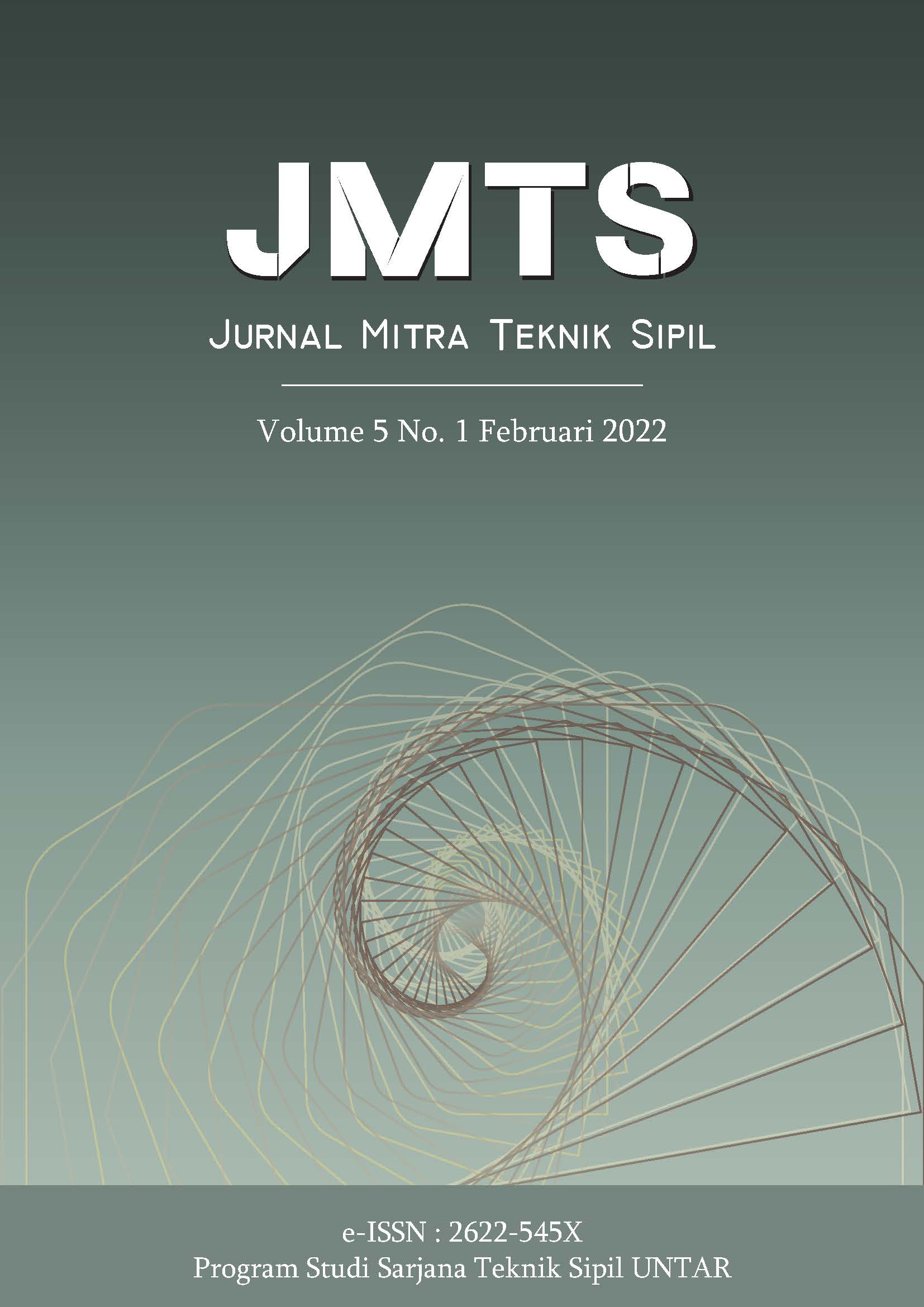STUDI PERILAKU TIANG AKIBAT INTERAKSI STRUKTUR DAN TANAH PADA BANGUNAN GEDUNG
Main Article Content
Abstract
ABSTRACT
The interaction between pile foundation and soil results a bearing capacity that allows the superstructure to be securely maintained. The interaction impact of the soil structure can lead to more accurate analysis, especially on structure's ability to endure seismic forces. Therefore, the pile foundation must be idealized as a multilinear spring support in order to analyze the interaction of the soil structure. The Midas GTS NX and Midas GEN programs were used to examine the impact of soil structure interactions. The program requires data such as superstructure models, soil factors, pile specifications, and pile bearing capacity. The z-direction deformation (-11,112 mm) and axial force (-2207,914 kN) on the C19-3 pile are both greater than in the corner and edge pile sites under gravity load condition. The z-direction deformation (2,909 mm) and the axial force (587,850 kN) on the C2-2 pile are both greater than in the corner and center pile sites under the x-direction static earthquake load condition. The z-direction deformation (2,909 mm) on the C4-6 pile and the axial force (587,850 kN) on the C4-7 pile are both greater than at the edge and center pile sites under the y-direction static earthquake load condition.
ABSTRAK
Interaksi antara fondasi tiang dengan tanah menghasilkan daya dukung yang dapat mempertahankan kondisi struktur atas dengan aman. Efek interaksi struktur tanah dapat menghasilkan analisis yang lebih akurat terutama pada kapasitas struktur dalam menahan gaya gempa. Oleh karena itu dalam analisis interaksi struktur tanah, fondasi tiang perlu diidealisasikan sebagai tumpuan pegas multilinear. Analisis efek interaksi struktur tanah dilakukan menggunakan program Midas GTS NX dan Midas GEN. Data yang diperlukan seperti permodelan struktur atas, parameter tanah, spesifikasi tiang, dan daya dukung tiang dimasukkan ke dalam program. Pada kondisi pembebanan gravitasi di tiang C19-3, deformasi arah z (-11,112 mm) dan gaya aksial (-2207,914 kN) kedua nilainya lebih besar daripada di lokasi tiang pojok maupun pinggir. Pada kondisi pembebanan gempa statik arah x di tiang C2-2, deformasi arah z (2,909 mm) dan gaya aksial (587,850 kN) kedua nilainya lebih besar daripada di lokasi tiang pojok maupun tengah. Pada kondisi pembebanan gempa statik arah y, deformasi arah z (2,909 mm) di tiang C4-6 dan gaya aksial (587,850 kN) di tiang C4-7 kedua nilainya lebih besar daripada di lokasi tiang pinggir maupun tengah.
Article Details
References
Alvi, S. D. (2021). Hand On MIDAS GTS NX : Exercise on Pile Group Analysis. UNPAR-MIDAS Geotechnical Forum Webinar. Bandung: PT. Midasindo Teknik Utama.
Arman, F. (2021). Multilinear Spring Function Analysis in Soil-Structure Interaction for Building. UNPAR-MIDAS Geotechnical Forum Webinar. Bandung: PT. Midasindo Teknik Utama.
Badan Standardisasi Nasional . (2017). Persyaratan Perancangan Geoteknik (SNI 8460:2017). Jakarta: Badan Standardisasi Nasional .
Badan Standardisasi Nasional. (2019). Tata Cara Perencanaan Ketahanan Gempa untuk Struktur Bangunan Gedung dan non Gedung (SNI 1726:2019). Jakarta: Badan Standarisasi Nasional.
Bowles, J. E. (1991). Analisis dan Desain Pondasi Jilid 2 Edisi Keempat. Jakarta: Penerbit Erlangga.
Das, B. M. (1993). Mekanika Tanah (Prinsip-Prinsip Rekayasa Geoteknis) Jilid 2. Jakarta: Penerbit Erlangga.
Geotechnical Engineering Center. (2005). Manual Pondasi Tiang. Bandung: Universitas Katolik Parahyangan.
Kurniawan, N. I., Wijaya, H., & Yuwono, A. (2021). Analisis Fondasi Tiang Pancang Akibat Respons Spektrum Gempa Untuk Wilayah Jakarta. Jurnal Mitra Teknik Sipil.
Meyerhof, G. G. (1976). Bearing Capacity and Settlement of Pile Foundations. Journal of the Geotechnical Engineering Division, 102, 197-228.
NIST GCR 12-917-21. (2012). Soil-Structure Interaction for Building Structures. NEHRP Consultants Joint Venture.
Vesic, A. S. (1961). Bending of Beams Resting on Isotropic Elastic Solid. ASCE, 87, 35-53.



